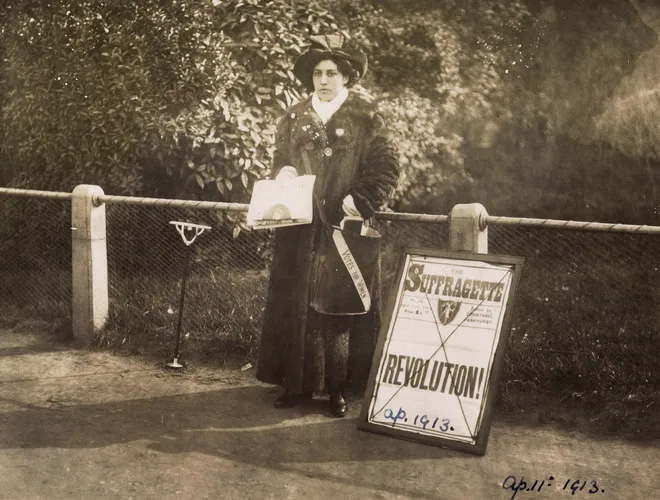The Suffragettes
Between 1903 and 1914, the Suffragette movement used radical protest tactics and a creative publicity campaign to demand women’s right to vote in the UK. “Deeds not words” was their motto, and over 1,300 women went to prison for the cause. Their stories are told in the world’s largest collections of objects linked to their campaign, held here at London Museum.

Who were the Suffragettes?
The Suffragettes were part of the votes for women campaign that had long fought for women’s right to vote in the UK. They used art, debate, propaganda and attacks on property to fight for female suffrage. Suffrage means the right to vote in parliamentary and general elections.
Who started the Suffragette movement?
Emmeline Pankhurst, her daughters Christabel, Sylvia and Adela, and a group of other women based in Manchester founded the Women’s Social and Political Union (WSPU) in 1903. They aimed to “wake up the nation” through “deeds not words”. This was the beginning of the Suffragette movement as we know it.
Meet the Pankhursts
-

Emmeline Pankhurst: Suffragette icon
Pankurst’s leadership of the militant votes-for-women campaign made her a feminist hero
-

Christabel Pankhurst: Suffragette leader
An inspiring leader whose radical tactics intensified women’s fight for the vote
-

Sylvia Pankhurst: Suffragette, artist, activist
This famous votes-for-women campaigner set herself apart as an artist and social activist
What did the Suffragettes do?
In 1906, the WSPU moved their headquarters to London, starting a highly public, increasingly confrontational struggle. Paid and volunteer staff organised fundraising events and huge demonstrations known as “monster meetings”. By 1909 their weekly newspaper had a circulation of 22,000. There were 90 UK offices, with 34 concentrated in London.
Suffragettes & suffragists
-

Millicent Fawcett: Suffragist, not Suffragette
Meet a leader of the law-abiding votes for women campaign
-

Sophia Duleep Singh: The Suffragette princess
For this Punjabi royal, winning women’s vote was worth breaking the law
-

Who was the Suffragette Emily Davison?
After running onto a racecourse, this votes for women campaigner lost her life for the cause
-

Kitty Marion: Actor & Suffragette
Battling for the vote with fire and hunger strikes
How and where did the Suffragettes protest?
The Suffragettes targeted the government in Whitehall by petitioning Downing Street, heckling MPs and chaining themselves to government buildings. Suffragettes also damaged London landmarks and works of art, smashed windows and bombed and burned buildings.
Over a thousand Suffragettes were sent to prison. At Holloway Prison in north London, some went on hunger strike. The government introduced force-feeding, then a release and re-arrest law known as the Cat and Mouse Act.
Protests & prison time
-

How Black Friday changed the Suffragette struggle
A day of aggression in the battle for women’s right to vote
-

Why did Suffragettes go on hunger strike?
Imprisoned for militant action, some Suffragettes went to extreme lengths to continue their protest
-

What was the 1911 Suffragette Women’s Coronation Procession?
Could an enormous march get the new king to support women’s right to vote?
Did the Suffragettes win the vote?
When the First World War began in 1914 the Suffragettes paused militant action to throw themselves into supporting the war effort instead. All Suffragette prisoners were released.
The WSPU didn’t win women the vote, but its campaigning style eased the way for women to take a more public role in society during the war. This role was recognised in 1918 when the vote was granted to a limited number of women over the age of 30.
Their legacy continues to inspire today. Even one of London's rail routes, the Suffragette line, is named in their honour.
The Suffragette legacy
-

The 1918 election: When women first voted
The first general election after the First World War saw huge changes in who could vote
-

An introduction to Christina Broom
The pioneering photographer who captured the Suffragettes in action
-

The forgotten Suffragettes & tales of militancy
These four forgotten champions who fought bravely for female suffrage
-

Are the Suffragettes still relevant today?
Hammers, banners and prison medals: How Suffragettes continue to inspire and provoke









